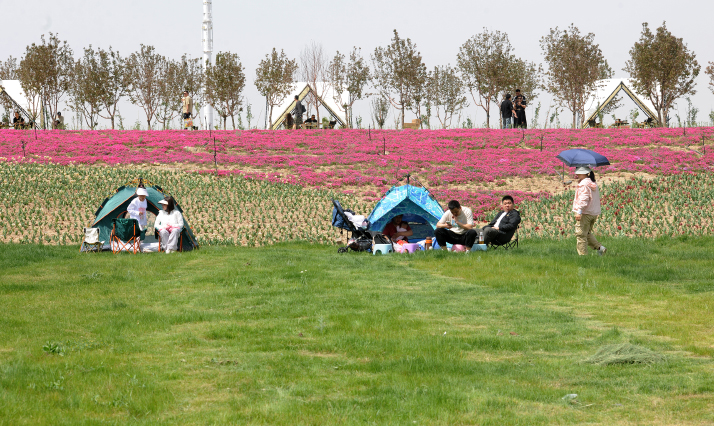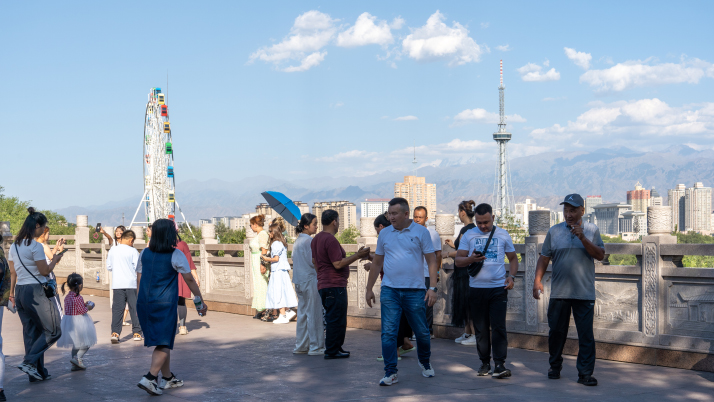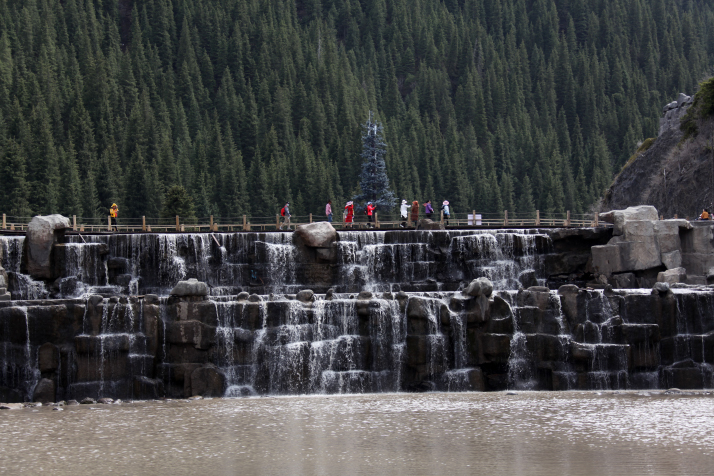| Xinjiang Today |
| Meet Urumqi | |
|
|
 A picturesque camping site in Urumqi on May 10 (VCG)
This is the geographical center of the Asian continent. This is the capital of Xinjiang. This is the largest city within a 1,500-km radius. Welcome to Urumqi.
Urumqi, which means "a beautiful pasture" in the ancient Mongolian language, is situated at the northern foothills of the Tianshan Mountain Range and the southern edge of the Junggar Basin. The Urumqi River flows from south to north through the city center. To the east stands Bogda Peak, the highest peak in the eastern section of the Tianshan Mountains at 5,400 meters above sea level that presents an awe-inspiring spectacle. The southern horizon is dominated by this majestic mountain range, making the Nanshan Resort on its southern suburbs an ideal getaway from the city's hustle and bustle. To the west lies Yaomo Mountain (Ghost Mountain), steeped in myth and legend. At the city's heart rises the Hongshan Hill (Red Hill)—a compact and steep hill where visitors can have a panoramic view of the city. Amid evolving tourism offerings and diverse cultural events, growing numbers of travelers are discovering Urumqi as their gateway to exploring Xinjiang's magnificent landscapes. In 2024, Urumqi received 121.1 million domestic and international tourist visits and generated 122.9 billion yuan ($17 billion) in tourism revenue, representing year-on-year increases of 14 percent and 19 percent, respectively. From mountain viewing in scenic parks to laughter-filled camping bases where groups gather around sizzling barbecues and from food streets with snaking queues patiently awaiting culinary creations to bustling commercial districts where sidewalk restaurants thrive and retail hotspots buzz with shoppers—the city pulses with lively tourism energy. These experiences invite travelers to embark on their Xinjiang adventure, to be captivated by the region's breathtaking landscapes and cultural richness.  An Akhal-Teke horse parade in August 2023 (XINHUA)
Tourism on horseback Leveraging Urumqi's Tourism on Horseback initiative, visitors immerse themselves in its equestrian culture through activities like carriage parades and Akhal-Teke horse performances. The Xinjiang Ancient Ecological Park in Urumqi has emerged as a social media hotspot. As China's largest Akhal-Teke breeding base, it houses over 400 of these prized horses alongside other world-class steeds, offering a showcase of global equine excellence. Akhal-Teke horses are a rare breed known for their superior speed, endurance and intelligence, mostly found in Central Asian countries such as Turkmenistan, Kazakhstan and Kyrgyzstan. Spanning 40,000 square meters, the park integrates breeding, exhibitions, training, competitions and equestrian fitness programs. Notably, it hosts China's only Akhal-Teke germplasm gene bank, achieving domestic breeding of this premium horse species. In recent years, Akhal-Teke horses bred there have won multiple awards at international equestrian events. Xinjiang's vast grasslands have propelled rapid growth in its horse industry, now leading China in both horse population and breeding expertise. The Akhal-Teke has become a cultural emblem of the region's thriving equine sector.  Hongshan Park offers a panoramic view of downtown Urumqi (VCG)
Comprehensive services Urumqi's tourism landscape is witnessing a transformation, with luxury glamping resorts proliferating, driving a shift toward personalized, diversified and upscale outdoor experiences. Multifaceted tourism formats have become key to creating destination-wide appeal. In Urumqi County, which lies on the southern outskirts of Urumqi City and is home to over 60 percent of the city's tourism resources, camps now offer family-friendly activities, mountain trekking, horseback riding, fishing, hotpot and barbecue feasts, plus recreational facilities like billiards and table tennis, prioritizing sustained visitor engagement. Traditional rural attractions are evolving into integrated complexes combining sightseeing, leisure, vacation stays and floral artistry. Take the International Grand Bazaar, Urumqi's iconic landmark, for instance. Newly developed areas like a naan culture courtyard, which familiarizes visitors with Xinjiang's staple food, and craft workshops now complement events such as a barbecue festival, circus performances and fashion shows, keeping visitors entertained from dawn till dusk. Urumqi's tourism offerings have expanded beyond conventional natural landscapes and historical sites to encompass rural tourism, winter sports, red tourism, or visits to historical revolutionary sites, theme parks, and camping bases. This comprehensive product matrix caters to diverse needs, from sightseeing and relaxation to educational travel and multi-layered vacation experiences.  The Tianshan Grand Canyon in Urumqi's Nanshan Resort in May 2023 (VCG)
Blue skies Urumqi achieved a historic breakthrough in 2024, recording 312 days of excellent air quality—the first time the northwestern metropolis has surpassed the 300-day mark. Residents celebrated the milestone by flooding social media with snapshots of crystal-clear skies, turning the city's environmental progress into a viral sensation. Key initiatives driving the transformation include phasing out vehicles that follow outdated emission standards, accelerating the adoption of new-energy vehicles, mainly electric vehicles, intensifying dust control at construction sites and strengthening regional collaborative mechanisms for air pollution prevention. Building on these gains, Urumqi's 2025 action plan prioritizes reducing heavy pollution episodes and slashing PM2.5 levels through structural reforms in industry, energy and transportation. PM2.5 refers to atmospheric particulate matter with a diameter of less than 2.5 micrometers, which can be inhaled. Focus areas include stricter regulation of coal-fired emissions, industrial pollutants, vehicle exhausts and urban non-point source pollution. Easy access From Urumqi, a four-hour flight provides access to Central Asia, South Asia and most of Southeast and East Asia, while an eight-hour flight connects the city to major global economic hubs across Europe, the Middle East, West Asia and North Africa. In 2024, Urumqi's international airport handled a record high of 27.76 million passenger throughput, securing its position as China's 18th busiest airport. With a new terminal beginning trial operations in April, the airport, recently renamed Urumqi Tianshan International Airport after the mountain range that bisects Xinjiang, is poised to help solidify the region's role as a pivotal gateway linking China with Central and Western Asia and beyond. Urumqi offers direct high-speed rail connections to other key cities in Xinjiang, forming a rapid transit network radiating from the city in two-, three- and four-hour travel circles. For instance, it takes 53 minutes to travel from Urumqi to Turpan, one hour and 10 minutes to Shihezi, two hours and 50 minutes to Karamay, three hours and 44 minutes to Kuerle (Korla), Bayingolin Mongolian Autonomous Prefecture, three hours and 57 minutes to Bole, Bortala Mongolian Autonomous Prefecture, and four hours and 56 minutes to Yining, Ili Kazak Autonomous Prefecture. These routes have dramatically cut travel time between Urumqi and other major cities in the region, highlighting the efficiency of Xinjiang's expanding rail system. Comments to yanwei@cicgamericas.com |
|
||||||||||||||||||||||||||||
|